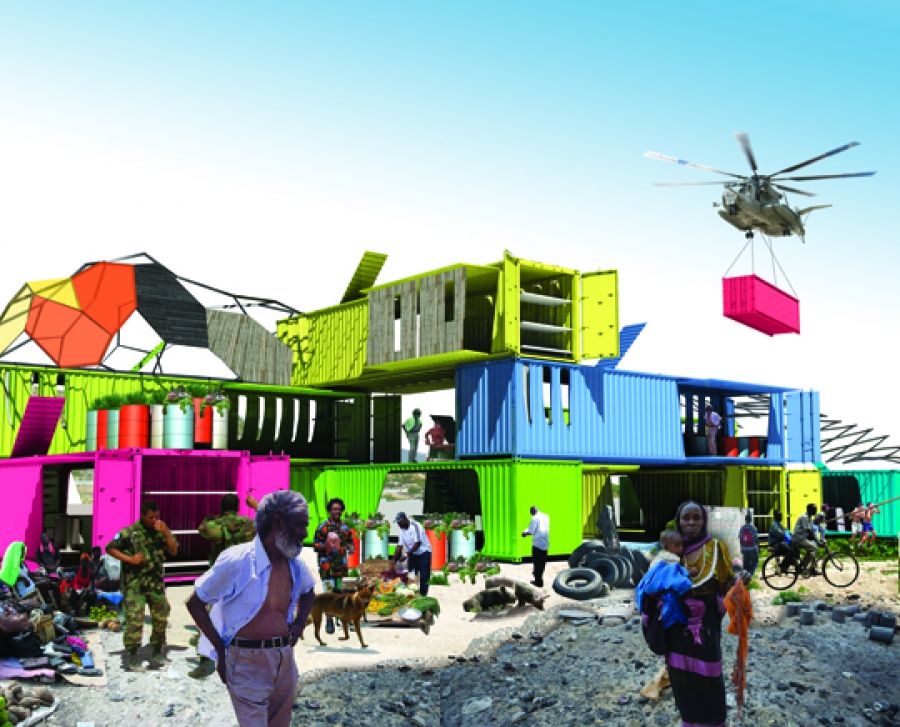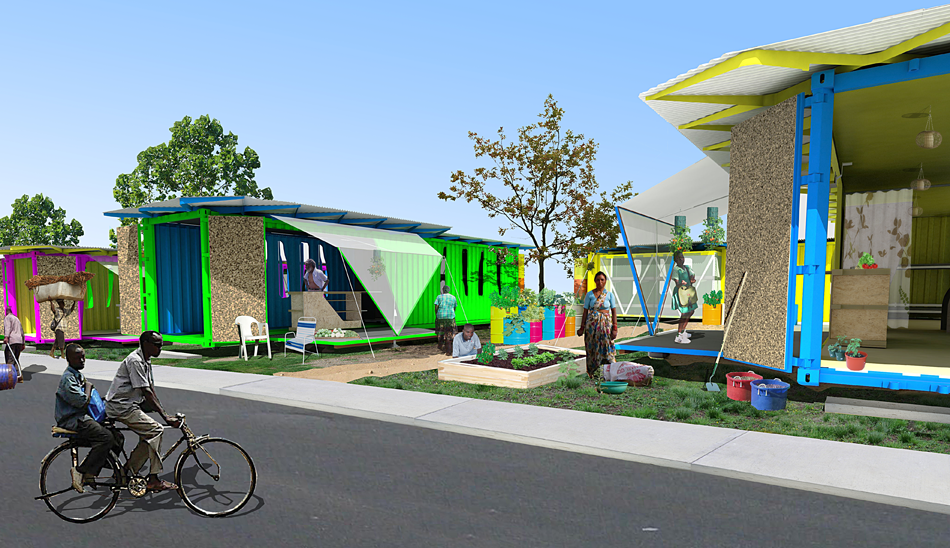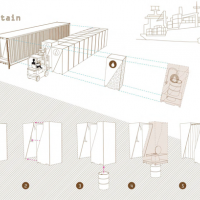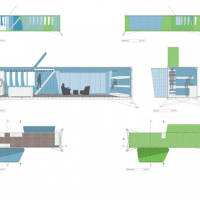The SEED Project at Clemson University: Safe Housing for Haitians
The earthquake in Haiti that hit on January 12, now seven months ago, left more than 230,000 people dead with 1.3 million homeless and 600,000 internally displaced. Undaunted not only by the immediate devastation of the quake but also by the political and governmental fragility that makes reconstruction difficult, Clemson School of Architecture Associate Professor Doug Hecker and Assistant Professor Martha Skinner continue to work to provide housing for Haitians long after they began an immediate post-quake creative search for emergency shelter for the displaced and homeless in Haiti. Their efforts resulted in the successful use of shipping containers as emergency housing -- the SEED_Haiti project.
 SEED_Haiti
Clemson University Architecture
SEED_Haiti
Clemson University Architecture
The recipient of an Environmental Protection Agency (EPA) grant and a subsequent winner at the sixth annual National Sustainable Design Expo on the National Mall in Washington, D.C., the Clemson University team of Hecker and Skinner continues to pursue a solution to this seemingly insurmountable problem. According to Hecker, “We knew all along after our initial research was done that we not only needed a Plan B but also Plans C, D, E, F, and beyond to effectively deal with Haiti’s long-term housing needs beyond the emergency needs of the people there, where there are only 70,000 mortgages in the entire country.”
In addition to the daunting challenges faced on the ground in Haiti, the professors also need to unite the research mission of Clemson University with the current efforts of SEED_Haiti to engage private industry to tackle a more permanent solution: to build humane container-based housing in Haiti as a jobs source and perhaps eventually an export industry.
Within weeks, Skinner and Hecker hope to announce a successful venture between SEED_Haiti and a private firm to assist Haitians in the construction of a manufactured housing factory in Port-Au-Prince to produce safe, structurally sound, healthy housing for residents of the country. Hecker cautions those who are overly skeptical of the containers as housing that “the standards for housing and acceptable living habits and the definition of healthy homes in Haiti are so different than in the U.S. that you really can’t compare the two. For example, we’re working to include perfectly acceptable mosquito screens in the houses’ openings, where windows would be expected by U.S. standards.” Hecker mentions that SEED_Haiti is cooperating with the World Bank and the Intermodal Steel Building Unit (ISBU) Association in their development of suitable, internationally adopted codes for the proper use of containers as housing.

In addition to the private enterprise housing manufacturing venture, the research team is also working with ARUP on an analysis of the structural integrity of the containers after cutting the openings in the walls and roof to make them inhabitable. So far ARUP’s conclusions are sufficiently positive to continue their participation in the project, with the aim that their environmental team will perform an energy analysis to confirm the suitability of the design’s rooftop “umbrella,” which will protect the units from the severe tropical heat.
“We’ve had some students that have completed their studio that want to be involved again and have graduating alumni that want to continue to be involved in another way. It’s finding a way to inspire students and put it all together. It’s not always easy doing that in an academic setting." Martha Skinner, Clemson School of Architecture Assistant Professor
The high-tech/low-tech work of Hecker is complemented by Skinner’s vital sociopolitical and human approach to SEED_Haiti. Skinner’s commitment is undeniable: she describes her sleepless nights thinking about the huge challenges Haitians face as they try not only to find decent, habitable housing but also to survive in this devastated land. According to Skinner, “The Haiti Response Initiative’s 10to10.org website name underscores our approach, simplified to powers of ten. Ten to the power of ten creates an exponential effect. In designing the effort, we are focusing on systems that would spread the availability of the container housing very quickly. How can the availability of ten of their surplus containers now eventually provide 100 homes? How can that be expanded to housing 1,000 people? Another concern is to be sensitive in the design that provides a home that’s not only safe but beautiful, responding to the site. That’s what kept me up at night, thinking of both what’s sensitive to the people we’re trying to help and still develop a system that is large. We’re exploring technologies like neighborhoods and the sensibilities of the culture to provide that sensitivity.”
Skinner notes that it hasn’t been easy to fit this project into a timeframe that works with the school year. “We work by combining service, research and teaching into one big collaboration that spans time,” Skinner says. “We’ve had some students that have completed their studio that want to be involved again and have graduating alumni that want to continue to be involved in another way. It’s finding a way to inspire students and put it all together. It’s not always easy doing that in an academic setting. We have to have people who understand that, and it’s amazing how the people who do understand provide a way for this to go in a very different direction than what’s typically found on a college campus. We had people in Haiti contact us and donate money to the project; they helped with fundraising. Not that all the pieces necessary have all fallen into place, but we’re making steady progress.”
Architectural opinions on the reuse of intermodal steel containers run from the negative, pointing to the recent container warehousing of construction workers in the Middle East, to a love affair with their use as a high-design response to sustainability, as in the MuvBox in Vancouver and coffee maker illy’s Push Button House, featured at the 2008 Venice Biennial.
“We knew all along after our initial research was done that we not only needed a Plan B but also Plans C, D, E, F, and beyond to effectively deal with Haiti’s long-term housing needs beyond the emergency needs of the people there, where there are only 70,000 mortgages in the entire country.” Doug Hecker, Clemson School of Architecture Associate Professor
SEED_Haiti is vitally important in this discourse. Housing is becoming critical as cities around the world grow beyond their abilities to handle their burgeoning populations, beyond a tacit approval of the extensive, teeming slums found in all of the developing world’s cities. Some very promising uses of containers are found, including their use as emergency hospital facilities that can be dispatched quickly, given their transportability. Similarly, an effort to provide medical clinics is also in development by the Massachusetts-based Containers to Clinics nonprofit.
How can you help? Skinner says, “Right now, pointing everyone to the Facebook fundraising page for people to join activities to build awareness. There remains an amazing commitment to what’s happening and we so appreciate the people who can support it. It’s called the SEED project for a reason. We designed a seed packet, as an analogy, where a lot of people have been influenced by the project from the start, when it was just an idea. We want to let people know that the seeds are spreading. This article is one part of that. There are going to be more challenges, anything that can show support so we can move as smoothly as possible will be very helpful. We got emails directly from Haitians right after the earthquake saying, ‘We have containers in the port, how can we help?’ It was an intense couple of months right after the earthquake. Of course things are still real bad, but we’re starting to hear from people again. It takes a lot of perseverance."
“The Facebook page and SEED blog that we have provide a dynamic, social space where people can be part of the effort,” Skinner says. “Once the media stopped writing about it there’s still discussion. There have been a lot of discussion groups and forums that we’re part of, but we don’t want to take part in all of them, we want to act. Care, think, and act. You can’t do just one or two. Articles like the one you’re writing are important so that the people of Haiti are not forgotten. We need to expose the work that’s happening to keep people excited about it."

Morey Bean, AIA, LEED AP
Colorado's 1999 Architect of the Year and Vice Chair of the Boulder Chapter of the Urban Land Institute, Morey’s experience includes the successful development of the Colorado Architecture Partnership, an architecture firm dedicated to sustainability and green building. Morey was appointed by the Chief Architect of the GSA to the National Register of Peer Professionals. He serves as a ULI Service Advisory Panelist and was a charter member of the Colorado Chapter of the USGBC and past president of the Colorado South Chapter of the AIA. He is a construction litigation services expert witness, land development analyst and sustainability strategies consultant.
The author was honored by the Colorado Component of the American Institute of Architects as their Architect of the Year in 1999 and is on the Roster of Neutrals for the American Arbitration Association (AAA), providing dispute settlement for the design and construction industry.
Website: www.cyberarchitects.com




